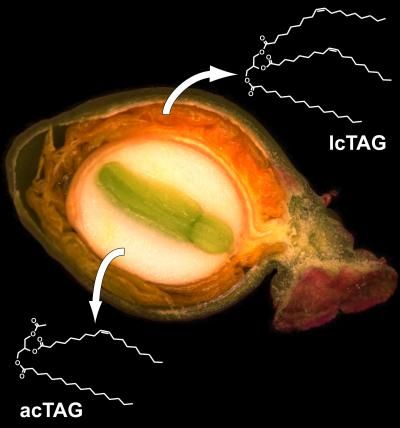Researchers trap moths with plant-produced sex pheromone
A collaborative experiment involving a Kansas State University biochemist may mark the beginning of an effective, environmentally friendly plant-based method of insect control.

This is a magnification of a burning bush seed that supplied the enzyme acTAG. The enzyme enabled researchers to engineer plants that emitted sex pheromones that mimic those naturally produced by two species of moths.
Timothy Durrett
Timothy Durrett, assistant professor of biochemistry and molecular biophysics, was part of the collaboration that used various plant and moth enzymes to engineer plants that emitted sex pheromones that mimic those naturally produced by two species of moths.
The research recently appeared in the journal Nature Communications, "A plant factory for moth pheromone production." The study was led by Christer Löfstedt of Lund University in Sweden and also included researchers from the Swedish University of Agricultural Sciences.
Pheromones are chemicals released from the body of animals and insects that are used to attract mates or relay danger. Currently, insect pests are managed with pesticides and synthetic pheromones — the latter of which confuse the insect and prevent it from breeding or enable it to be trapped.
"While these pheromones can be made chemically, it can be a toxic process to produce them," Durrett said. "What we demonstrated in this study is a more environmentally friendly approach that avoids the need to use toxic chemicals and eliminates hazardous byproducts from producing synthetic pheromones. The plant just handles everything."
The study focused on the bird-cherry ermine moth and the orchard ermine moth — two insects that feed on the leaves of orchard trees and, as caterpillars, can strip trees of their bark.
Durrett helped the Swedish researchers use enzymes from plants and moths to create a biological pathway that made it possible for plants to produce the moths' sex pheromones. He contributed an enzyme from the burning bush plant that performed the final step in the synthesis process, essentially turning plants into pheromone production factories.
Once the correct combination of enzymes was finalized, researchers modified Nicotiana benthamiana, an Australian plant that is closely related to tobacco plant.
The result was plants that produced pheromones that mimicked the sex pheromones of both moth species.
The Swedish researchers baited moth traps with the plant-produced pheromone. They found that each trap attracted an average of 130 male moths — half the number of catches possible with synthetic pheromones but enough to demonstrate the effectiveness of the biosynthetic method.
While a proof-of-concept experiment, engineering plants to be insect pheromone-producing factories creates an environmentally friendly alternative to pesticides as well as an easier and less expensive method of synthesizing insect pheromones, Durrett said.
"None of the enzymes that were put together would interact with each other naturally, so it was really exciting to see this pathway work and be as effective as it is," Durrett said.
Most read news
Organizations
Other news from the department science

Get the chemical industry in your inbox
By submitting this form you agree that LUMITOS AG will send you the newsletter(s) selected above by email. Your data will not be passed on to third parties. Your data will be stored and processed in accordance with our data protection regulations. LUMITOS may contact you by email for the purpose of advertising or market and opinion surveys. You can revoke your consent at any time without giving reasons to LUMITOS AG, Ernst-Augustin-Str. 2, 12489 Berlin, Germany or by e-mail at revoke@lumitos.com with effect for the future. In addition, each email contains a link to unsubscribe from the corresponding newsletter.


























































